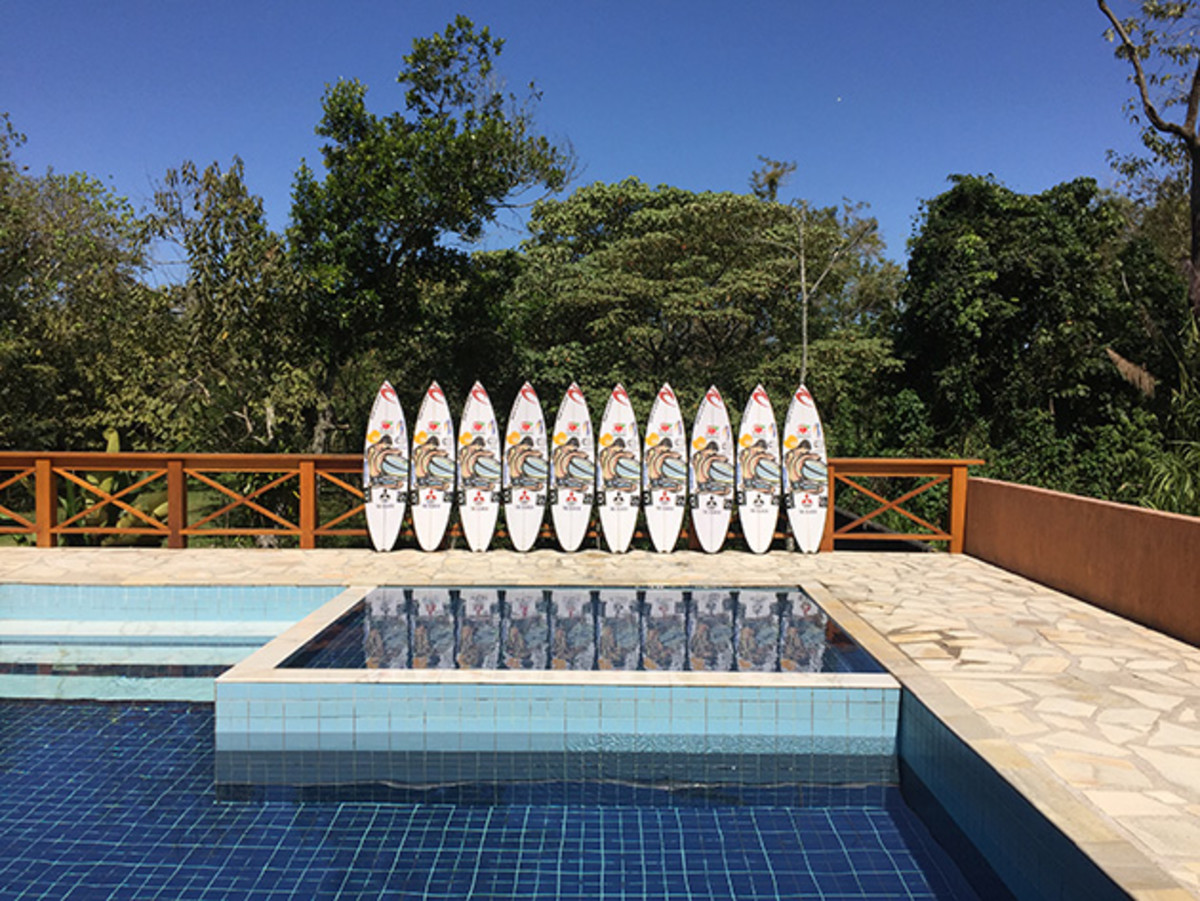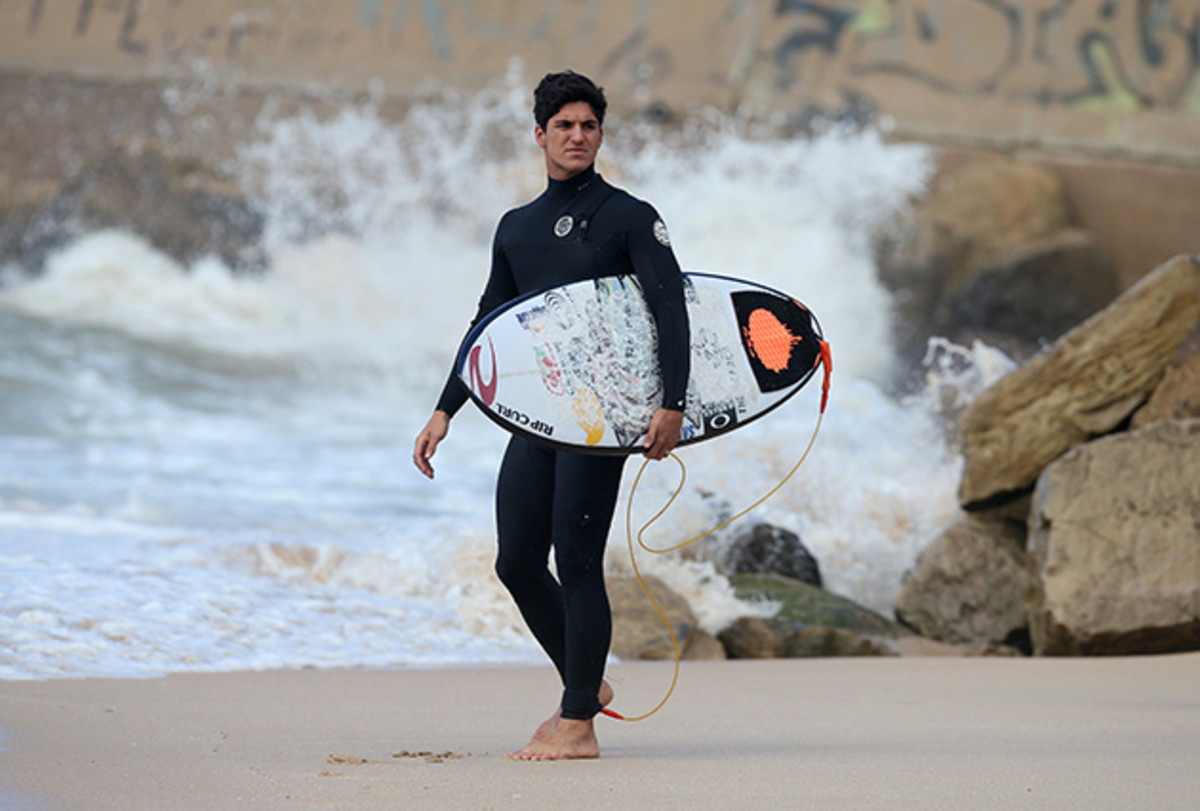The Art of Surfing: Can board design really affect performance, scoring?

Five minutes before the 2015 Quiksilver Pro final in Hossegor, France, Gabriel Medina stopped at the shoreline. He knelt down, folded his arms atop his board, and bowed his head in prayer.
Any spectator who needed a reminder of Medina’s pre-heat ritual could simply look at the deck of his board. Amid 10 sponsor logo stickers, it featured a painting of Medina in the same pose. The portrait was on all 18 boards he brought to France.
“I don’t know if it [the artwork] was lucky but he started surfing better,” Johnny Cabianca, Medina’s shaper, says with a laugh.
A few weeks prior to the Billabong Pro at Jeffreys Bay, South Africa, Charles Serrano, Medina’s stepfather, reached out to Cabianca. He wanted to add the portrait—painted by Brazilian artist Nando Martins—to all of Medina’s new boards as a surprise. Cabianca went to work. He printed the portrait on laminate paper, then glassed it underneath the fiberglass and polyurethane resin that coats the boards. Medina loved it. His performance improved. After a disappointing first half on the CT, Medina reeled off 5th, 2nd, and 3rd place finishes. Then he won the Quiksilver Pro France and launched into the title race with two events remaining. He finished third overall.
Grain Surfboards produces works of wave art, each handcrafted in wood
While the designs on Medina’s boards last year were probably the most self-reverential, the only thing that might be as eye-catching on the men’s and women’s World Surf League Championship Tours (WT) as the surfing itself, are the artistic displays on the surfers’ boards. Some louder choices have included cartoon characters, sports cars, expressions of faith, lions, and even rapper Wiz Kalifa.
They can also champion causes, like the pink artwork that Julian Wilson has sported on his boards since 2008 at the Quiksilver Pro Gold Coast in Coolangatta, Australia. Wilson’s mother, Nola, is a breast cancer survivor and his inspiration for the pink-themed equipment (Nola also helps design the pink boardshorts that Wilson wears during the contest). In years past, he has auctioned one or two painted boards with the proceeds benefiting the National Breast Cancer Foundation.
Still, the hue that received the most attention last year was Mick Fanning’s yellow bottomed boards, especially the one he rode during the final of Billabong Pro at J-Bay, when fought off a shark attack. In the following weeks, Fanning chose to alter the color of his equipment. Instead of the “yum yum yellow” that he previously favored, he switched to blue with black stripes in a variety of patterns—believed to mitigate the risk of an attack.

“Hopefully that deters them a bit more,” Fanning said before the Billabong Pro Tahiti. “Maybe somebody could do some better research on the stuff, but that’s all I could come up with.”
Carl Meyer, specializes in that “stuff.” He’s a researcher at the Hawaii Institute of Marine Biology and does not share Fanning’s optimism about the effectiveness of board color or striped patterns as a shark deterrent.
“Shark eyesight varies considerably among species, but white and tiger shark eye morphology suggests good contrast vision,” Meyer told SI.com via email. “The contrast target (silhouette) at the surface is probably of much more interest than the color of the object. Note also that sharks use a variety of senses to hone in on potential prey. In most cases, sharks detect low frequency vibrations from potential prey before they see them.”
Most pros surfers, though, probably consider aesthetics more than protection when deciding on their board art. The desire for an original look is hardly a new phenomenon. From Gerry Lopez’s “Lightning Bolt” boards, to the clean black outline of Tom Curren’s “Black Beauty,” to Andy Irons’ “Rising Sun,” board art has become intertwined with surfing’s most iconic figures and defined eras. But whereas pro models in snowboarding and skateboarding have signature artwork, surfers and surfboard companies mostly avoid that trend.
“Every board spray goes out of fashion quite quick,” says Darren Handley, whose DHD surfboards are under Fanning’s feet and several other CT pros. “I think surfing is more about individuality. No one wants to be walking down the beach with someone else’s exact board.”
Glenn Hall is expanding the role of the competitor coach in pro surfing
Industries” label since 1998, decorated both quivers.
Surfboards as a whole can be considered art. The intersection was evident in the summer of 2014, when five Haydenshapes boards were displayed in an installation in designer Alexander Wang’s New York City flagship store. Hayden Cox, the founder of Haydenshapes, hand-shaped five of his bestselling “Hypto Krypto” model boards, which were then inlayed with a marble print.

in Mona Vale, a suburb of Sydney, has the feel of an immersive, modern art gallery. “A surfboard is the vehicle that allows you to ride a wave, but it’s also an extension of a surfer’s personality.”
But as another year of the CT commences, and with some heats decided by fractions of a point, can artwork on a board extend beyond merely looks and influence performance?
It depends who you ask.
“Nowadays, these guys are doing such massive airs,” Handley says. “If they are on the same size wave, do the same air at the same height, the surfer with color on his board is going to get a higher score.”
“I love the look of white boards when they are new,” says CT surfer Matt Wilkinson, who rides DHDs. “But out in the water, colors really pop. Sometimes I think it might show what your board is doing and make the score better, but at the top level the judges should usually get the scores correct no matter the color of your board.”
As in any art form, there are a variety of mediums: there are resin tints and airbrushes. But one of the most popular options are water-based paint pens, such as Posca Pens, which you apply to a finished board then coat in a light, Krylon clear coat spray to seal the design.
“What you see today is a celebration of the possibilities,” says Drew Brophy, who pioneered using paint pens on surfboards for …Lost in the 1990s. “Everyone wants something that is unique and custom.”
Some artistically inclined surfers take a DIY approach, while others rely on more practiced hands like Terry Shin at …Lost or Turner at JS. An added benefit of the artwork is that it can help a pro distinguish a board from the roughly 100 others they get each year. Cabianca, who shaped 105 boards for Medina last year, says the former world champ’s quiver for Australia adheres to this rule. The boards, which have black rails and neon colors on the entire underside, are grouped by length. The 5’11” boards are orange. The 6’0” boards are “electric blue.”
“That way I know which one he’s riding when I watch the webcast,” Cabianca says.
The SI Extra Newsletter Get the best of Sports Illustrated delivered right to your inbox
Subscribe
So whether you’re trying to win heats or make a statement in your local lineup, Brophy insists that all surfboard art should aspire to a simple goal.
“You are just trying to make the board look good,” he says. “You’re not creating a masterpiece.”
